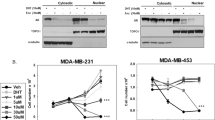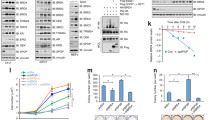Abstract
Objective
The bromodomain and extra-terminal (BET) family of proteins provides a scaffolding platform for the recruitment and tethering of transcription factors to acetylated chromatin, thereby modulating gene expression. In this study, we evaluated the efficacy of the BET-inhibitor PFI-1 to diminish AR/AR-V7 signaling and proliferation in castration-resistant prostate cancer cells.
Methods
Prostate-specific antigen and androgen receptor (AR) protein were quantified by means of two commercial ELISAs. Transactivation of the AR, AR-V7 and Q641X was determined by reporter gene assays. Cell proliferation was measured using a colorimetric MTT-assay.
Results
PFI-1 dose-dependently inhibited transactivation of full-length AR (non- mutated, i.e., wild-type or point-mutated/promiscuous forms) without affecting their cellular protein levels. Moreover, PFI-1 was active against C-terminally truncated constitutively active ARs like AR-V7 and Q641X. Prostate cancer cells exhibiting a transcriptionally active AR-signaling complex (LNCaP, 22Rv1) were more susceptible to the growth-inhibitory effects than the AR-negative PC-3 cells.
Conclusion
The quinazolinone PFI-1 is a highly efficient inhibitor of AR-signaling-competent prostate cancer cells in vitro. PFI-1 could serve as a lead compound for the development of new therapeutics able to block AR/AR-V7 signaling in advanced prostate cancer.




Similar content being viewed by others
References
Azoitei A, Merseburger AS, Godau B, Hoda MR, Schmid E, Cronauer MV (2017) C-terminally truncated constitutively active androgen receptor variants and their biologic and clinical significance in castration-resistant prostate cancer. J Steroid Biochem Mol Biol 166:38–44
Lapouge G, Erdmann E, Marcias G, Jagla M, Monge A, Kessler P, Serra S, Lang H, Jacqmin D, Bergerat JP, Céraline J (2007) Unexpected paracrine action of prostate cancer cells harboring a new class of androgen receptor mutation—a new paradigm for cooperation among prostate tumor cells. Int J Cancer 121:1238–1244
Han D, Gao S, Valencia K, Owiredu J, Han W, de Waal E, Macoska JA, Cai C (2017) A novel nonsense mutation in androgen receptor confers resistance to CYP17 inhibitor treatment in prostate cancer. Oncotarget 8:6796–6808
Asangani IA, Dommeti VL, Wang X, Malik R, Cieslik M, Yang R, Escara-Wilke J, Wilder-Romans K, Dhanireddy S, Engelke C, Iyer MK, Jing X, Wu YM, Cao X, Qin ZS, Wang S, Feng FY, Chinnaiyan AM (2014) Therapeutic targeting of BET bromodomain proteins in castration-resistant prostate cancer. Nature 510:278–282
Chan SC, Selth LA, Li Y, Nyquist MD, Miao L, Bradner JE, Raj GV, Tilley WD, Dehm SM (2015) Targeting chromatin binding regulation of constitutively active AR variants to overcome prostate cancer resistance to endocrine-based therapies. Nucleic Acids Res 43:5880–5897
Fujisawa T, Filippakopoulos P (2017) Functions of bromodomain-containing proteins and their roles in homeostasis and cancer. Nat Rev Mol Cell Biol 18:246–262
Taniguchi Y (2016) The bromodomain and extra-terminal domain (BET) family: functional anatomy of BET paralogous proteins. Int J Mol Sci 17:1849. https://doi.org/10.3390/ijms17111849
Wu SY, Chiang CM (2007) The double bromodomain-containing chromatin adaptor Brd4 and transcriptional regulation. J Biol Chem 282:13141–13145
Wyce A, Degenhardt Y, Bai Y, Le B, Korenchuk S, Crouthame MC, McHugh CF, Vessella R, Creasy CL, Tummino PJ, Barbash O (2013) Inhibition of BET bromodomain proteins as a therapeutic approach in prostate cancer. Oncotarget 4:2419–2429
Fish PV, Filippakopoulos P, Bish G, Brennan PE, Bunnage ME, Cook AS, Federov O, Gerstenberger BS, Jones H, Knapp S, Marsden B, Nocka K, Owen DR, Philpott M, Picaud S, Primiano MJ, Ralph MJ, Sciammetta N, Trzupek JD (2012) Identification of a chemical probe for bromo and extra C-terminal bromodomain inhibition through optimization of a fragment-derived hit. J Med Chem 55:9831–9837
Picaud S, Da Costa D, Thanasopoulou A, Filippakopoulos P, Fish PV, Philpott M, Fedorov O, Brennan P, Bunnage ME, Owen DR, Bradner JE, Taniere P, O’Sullivan B, Müller S, Schwaller J, Stankovic T, Knapp S (2013) PFI-1, a highly selective protein interaction inhibitor, targeting BET bromodomains. Cancer Res 73:3336–3346
Schütz SV, Schrader AJ, Zengerling F, Genze F, Cronauer MV, Schrader M (2011) Inhibition of glycogen synthase kinase-3β counteracts ligand-independent activity of the androgen receptor in castration resistant prostate cancer. PLoS One 6(9):e25341
Streicher W, Zengerling F, Laschak M, Weidemann W, Höpfner M, Schrader AJ, Jentzmik F, Schrader M, Cronauer MV (2012) AR-Q640X, a model to study the effects of constitutively active C-terminally truncated AR variants in prostate cancer cells. World J Urol 30:333–339
Zengerling F, Azoitei A, Herweg A, Jentzmik F, Cronauer MV (2016) Inhibition of IGF-1R diminishes transcriptional activity of the androgen receptor and its constitutively active, C-terminally truncated counterparts Q640X and AR-V7. World J Urol 34:633–639
Mosmann T (1983) Rapid colorimetric assay for cellular growth and survival: application to proliferation and cytotoxicity assays. J Immunol Methods 65:55–63
Merseburger AS, Hammerer P, Rozet F, Roumeguère T, Caffo O, da Silva FC, Alcaraz A (2015) Androgen deprivation therapy in castrate-resistant prostate cancer: how important is GnRH agonist backbone therapy? World J Urol 33(8):1079–1085
Perner S, Cronauer MV, Schrader AJ, Klocker H, Culig Z, Baniahmad A (2015) Adaptive responses of androgen receptor signaling in castration-resistant prostate cancer. Oncotarget 6:35542–35555
Jentzmik F, Azoitei A, Zengerling F, Damjanoski I, Cronauer MV (2016) Androgen receptor aberrations in the era of abiraterone and enzalutamide. World J Urol 34:297–303
Sadar MD (2012) Advances in small molecule inhibitors of androgen receptor for the treatment of advanced prostate cancer. World J Urol 30:311–318
Dalal K, Roshan-Moniri M, Sharma A, Li H, Ban F, Hassona MD, Hsing M, Singh K, LeBlanc E, Dehm S, Tomlinson Guns ES, Cherkasov A, Rennie PS (2014) Selectively targeting the DNA-binding domain of the androgen receptor as a prospective therapy for prostate cancer. J Biol Chem 289:26417–26429
Antonarakis ES, Chandhasin C, Osbourne E, Luo J, Sadar MD, Perabo F (2016) Targeting the N-terminal domain of the androgen receptor: a new approach for the treatment of advanced prostate cancer. Oncologist 21:1427–1435
Hupe MC, Offermann A, Perabo F, Chandhasin C, Perner S, Merseburger AS, Cronauer MV (2018) Inhibitors of the androgen receptor N-terminal domain: therapies targeting the Achilles’ heel of various androgen receptor molecules in advanced prostate cancer. Urol A 57:148–154
Culig Z, Santer FR (2012) Androgen receptor co-activators in the regulation of cellular events in prostate cancer. World J Urol 30:297–302
Foley C, Mitsiades N (2016) Moving beyond the androgen receptor (AR): targeting AR-interacting proteins to treat prostate cancer. Horm Cancer 7:84–103
Fu LL, Tian M, Li X, Li JJ, Huang J, Ouyang L, Zhang Y, Liu B (2015) Inhibition of BET bromodomains as a therapeutic strategy for cancer drug discovery. Oncotarget 6:5501–5516
Raina K, Lu J, Qian Y, Altieri M, Gordon D, Rossi AM, Wang J, Chen X, Dong H, Siu K, Winkler JD, Crew AP, Crews CM, Coleman KG (2016) PROTAC-induced BET protein degradation as a therapy for castration-resistant prostate cancer. Proc Natl Acad Sci USA 113:7124–7129
Faivre EJ, Wilcox D, Lin X, Hessler P, Torrent M, He W, Uziel T, Albert DH, McDaniel K, Kati W, Shen Y (2017) Exploitation of castration-resistant prostate cancer transcription factor dependencies by the novel BET inhibitor ABBV-075. Mol Cancer Res 15:35–44
Ferri E, Petosa C, McKenna CE (2016) Bromodomains: structure, function and pharmacology of inhibition. Biochem Pharmacol 106:1–18
Mladenova V, Mladenov E, Russev G (2014) Organization of plasmid DNA into nucleosome-like structures after transfection in eukaryotic cells. Biotechnol Biotechnol Equip 23(1):1044–1047. https://doi.org/10.1080/13102818.2009.10817609
Peternac D, Klima I, Cecchini MG, Studer UE, Thalmann GN (2006) Prostate specific antigen expression does not necessarily correlate with prostate cancer cell growth. J Urol 176:354–360
Asangani IA, Wilder-Romans K, Dommeti VL, Krishnamurthy PM, Apel IJ, Escara-Wilke J, Plymate SR, Navone NM, Wang S, Feng FY, Chinnaiyan AM (2016) BET bromodomain inhibitors enhance efficacy and disrupt resistance to AR antagonist in the treatment of prostate cancer. Mol Cancer Res 14:324–331
Shah N, Wang P, Wongvipat J, Karthaus WR, Abida W, Armenia J, Rockowitz S, Drier Y, Bernstein BE, Long HW, Freedman ML, Arora VK, Zheng D, Sawyers CL (2017) Regulation of the glucocorticoid receptor via a BET-dependent enhancer drives antiandrogen resistance in prostate cancer. Elife 6:e27861. https://doi.org/10.7554/elife.27861
Filippakopoulos P, Qi J, Picaud S, Shen Y, Smith WB, Fedorov O, Morse EM, Keates T, Hickman TT, Felletar I, Philpott M, Munro S, McKeown MR, Wang Y, Christie AL, West N, Cameron MJ, Schwartz B, Heightman TD, La Thangue N, French CA, Wiest O, Kung AL, Knapp S, Bradner JE (2010) Selective inhibition of BET bromodomains. Nature 468:1067–1073
Acknowledgements
The authors wish to thank Beate Godau and Christine Marschke for expert technical assistance.
Author information
Authors and Affiliations
Contributions
MCH: data collection and protocol development; MHR: data collection; FZ: data collection; SP: data analysis; ASM: data analysis and manuscript writing/editing; MVC: project development, data analysis, and manuscript writing.
Corresponding author
Ethics declarations
Conflict of interest
The authors declare that they have no conflict of interest.
Research involving human participants and/or animals
This article does not contain any studies with human participants or animals performed by any of the authors.
Electronic supplementary material
Below is the link to the electronic supplementary material.
Rights and permissions
About this article
Cite this article
Hupe, M.C., Hoda, M.R., Zengerling, F. et al. The BET-inhibitor PFI-1 diminishes AR/AR-V7 signaling in prostate cancer cells. World J Urol 37, 343–349 (2019). https://doi.org/10.1007/s00345-018-2382-8
Received:
Accepted:
Published:
Issue Date:
DOI: https://doi.org/10.1007/s00345-018-2382-8




